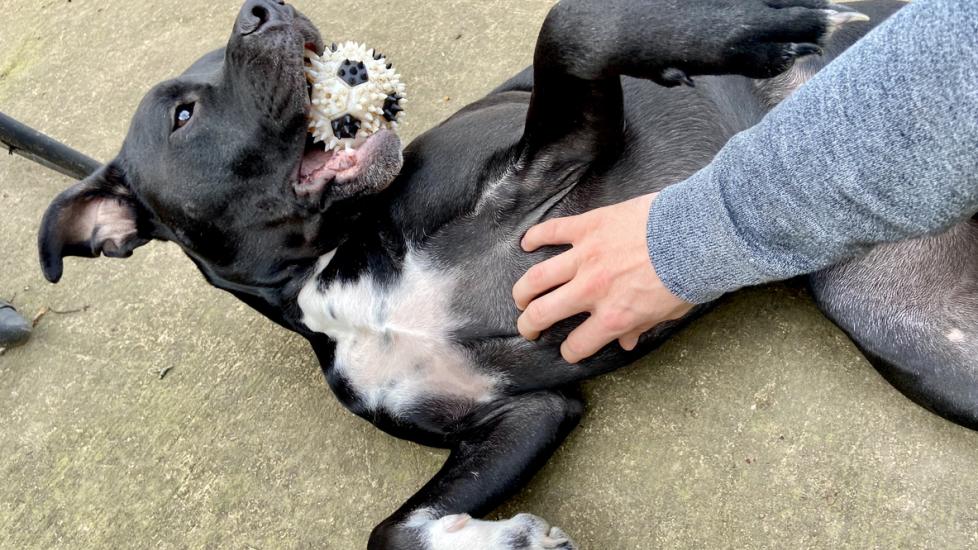Dog Peritonitis
What is Dog Peritonitis?
Peritonitis is a condition in which the membrane that lines abdominal cavity (called the peritoneum) becomes inflamed, often due to injury or infection. The peritoneum is a thin, watery lining that lubricates the abdominal organs (such as the stomach).
This can cause fluid to build up in the abdomen. Peritonitis can be a very serious and life-threatening condition in dogs and requires immediate treatment.
Health Tools
Not sure whether to see a vet?
Symptoms of Dog Peritonitis
Symptoms of peritonitis vary widely and can be confused with symptoms caused by many other conditions. If your dog shows any of the following signs, bring them to your veterinarian immediately (especially if your dog exhibits two or more symptoms).
Abdominal pain is a very common symptom of peritonitis. Dogs may show abdominal pain by appearing in a “prayer” position (rear end up in the air while their front legs and head are lowered onto the floor). Abdominal distension or bloating may also occur.
Other signs of illness include:
-
Vomiting, nausea, or refusing to eat
-
Diarrhea
-
Fever
-
Weakness and lack of energy
-
Dehydration
-
Pale gums
Causes of Peritonitis in Dogs
Peritonitis occurs when the abdominal cavity becomes injured and inflamed, so the condition has many possible causes. For example, peritonitis can occur when a dog suffers a penetrating injury or blunt trauma to the abdomen (such as wounds sustained from stabbing or kicking).
Intestinal blockages caused by swallowing foreign objects can also lead to peritonitis.
Other possible causes include:
-
Ruptured bladder, uterus, or gall bladder
-
Tears in surgical sites
-
Ulcers (ulcer-related holes in the stomach lining can be caused by medication like non-steroidal anti-inflammatories or NSAIDs)
-
Abdominal tumors
-
Disorders of other internal organs (e.g., heart, kidneys, liver, spleen, or pancreas)
-
Twisted stomach or bloat
-
Liver inflammation (hepatitis)
Less frequently, peritonitis can be caused by blood-borne infection (e.g., bacterial, viral, fungal, or parasitic). Rarely, the cause of the peritonitis is unknown or cannot be determined.
Although not inherited, some breeds have a higher likelihood of developing conditions that lead to peritonitis. For example, young large-breed dogs such as Labrador Retrievers may be more likely to swallow a foreign object (such as a sock or underwear), causing an intestinal blockage and rupture that results in peritonitis.
On the other hand, breeds like miniature Schnauzers are more prone to pancreatitis, which also can lead to peritonitis. Finally, giant breed dogs such as Great Danes will be more likely to develop “twisted” stomach” (gastric dilatation and volvulus).
How Veterinarians Diagnose Dog Peritonitis
Diagnosing peritonitis begins with a physical examination to check for abdominal pain and fever. Your veterinarian will ask about your dog’s medical history, including recent surgical procedures and current medications (particularly NSAIDs).
You will also be asked about potential trauma and anything your dog might have swallowed. Other tests commonly used to investigate peritonitis include:
-
A blood test to assess overall organ function, white blood cell count and dehydration
-
Abdominal x-rays to look for fluid within the abdomen as well as intestinal blockage or masses
-
Abdominal ultrasound to confirm the presence of fluid in the abdomen
-
A fluid sample drawn from a needle (abdominocentesis) to check for inflammatory cells and bacteria
Treatment for Dog Peritonitis
If the test results indicate peritonitis, your dog will need to be hospitalized and be put on IV fluids. Medication will be given to treat symptoms of nausea, pain, and diarrhea. Antibiotics will also likely be an important part of your pet’s care.
Emergency surgery is usually required to repair the underlying cause of the inflammation, such as a rupture, wound, or abscess. In rare cases where the specific cause of the peritonitis cannot be identified, the surgeon will rinse the abdomen with sterile saline.
Recovery and Management of Peritonitis in Dogs
Diagnosing and treating peritonitis as soon as possible is key to achieving the best outcome and minimizing complications. Recovering from this serious condition often requires 3 to 5 days (and sometimes more) following surgery.
During this time, IV fluids, antibiotics, and nutritional support are required. Unfortunately, even with intensive support the survival rate is about 50%. If sepsis has set in, the survival rate is lower.
Your veterinarian will discharge your dog when she is fever-free and can eat without throwing up. Expect a full recovery to take 10-14 days of rest with minimal activity.
Depending on what caused the peritonitis in the first place, your dog can make a complete recovery and resume normal activity. For example, if peritonitis was caused by swallowing a foreign object, then it will be important to prevent a future occurrence.
If the peritonitis was the result of an underlying issue, such as a bowel rupture caused by a tumor, then more extensive tests are required to diagnose and treat the cause.
Dog Peritonitis FAQs
Can peritonitis be cured in dogs?
Peritonitis in dogs is treatable. However, it is a very serious condition that can quickly become life-threatening and requires immediate, intensive veterinary care, including hospitalization and often surgery.
What causes septic peritonitis in dogs?
The most common cause of peritonitis in dogs is a hole (perforation) in an internal organ, which can occur from a penetrating abdominal wound, ruptured intestines (from blockage or ulceration), splitting open (dehiscence) of surgical site(s), or erosion of stomach or intestines from a tumor. This can lead to a serious and life-threatening bacterial infection (sepsis) and requires immediately veterinary care.
Featured Image: iStock.com/Brad Covington
Help us make PetMD better
Was this article helpful?
